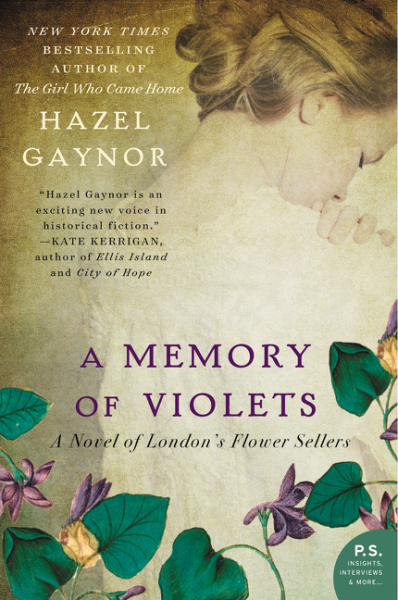
A MEMORY OF VIOLETS
A Novel of London’s Flower Sellers
The author of the USA Today and New York Times bestselling novel The Girl Who Came Home has once again created an unforgettable historical novel. Step into the world of Victorian London, where the wealth and poverty exist side by side. This is the story of two long-lost sisters, whose lives take different paths, and the young woman who will be transformed by their experiences.
In 1912, twenty-year-old Tilly Harper leaves the peace and beauty of her native Lake District for London, to become assistant housemother at Mr. Shaw’s Home for Watercress and Flower Girls.
The author of the USA Today and New York Times bestselling novel The Girl Who Came Home has once again created an unforgettable historical novel. Step into the world of Victorian London, where the wealth and poverty exist side by side. This is the story of two long-lost sisters, whose lives take different paths, and the young woman who will be transformed by their experiences.
In 1912, twenty-year-old Tilly Harper leaves the peace and beauty of her native Lake District for London, to become assistant housemother at Mr. Shaw’s Home for Watercress and Flower Girls. For years, the home has cared for London’s flower girls—orphaned and crippled children living on the grimy streets and selling posies of violets and watercress to survive.
Soon after she arrives, Tilly discovers a diary written by an orphan named Florrie—a young Irish flower girl who died of a broken heart after she and her sister, Rosie, were separated. Moved by Florrie’s pain and all she endured in her brief life, Tilly sets out to discover what happened to Rosie. But the search will not be easy. Full of twists and surprises, it leads the caring and determined young woman into unexpected places, including the depths of her own heart.
- William Morrow
- Paperback
- March 2015
- 432 Pages
- 9780062316899
About Hazel Gaynor
 Hazel Gaynor‘s 2014 debut novel The Girl Who Came Home—A Novel of the Titanic was a New York Times and USA Today bestseller. A Memory of Violets is her second novel. Hazel writes a popular guest blog ‘Carry on Writing’ for national Irish writing website writing.ie and contributes regular feature articles for the site, interviewing authors such as Philippa Gregory, Sebastian Faulks, Cheryl Strayed, Rachel Joyce and Jo Baker, among others. Hazel was the recipient of the 2012 Cecil Day Lewis award for Emerging Writers and was selected by Library Journal as one of Ten Big Breakout Authors for 2015. She appeared as a guest speaker at the Romantic Novelists’ Association and Historical Novel Society annual conferences in 2014. Originally from Yorkshire, England, Hazel now lives in Ireland with her husband and two children.
Hazel Gaynor‘s 2014 debut novel The Girl Who Came Home—A Novel of the Titanic was a New York Times and USA Today bestseller. A Memory of Violets is her second novel. Hazel writes a popular guest blog ‘Carry on Writing’ for national Irish writing website writing.ie and contributes regular feature articles for the site, interviewing authors such as Philippa Gregory, Sebastian Faulks, Cheryl Strayed, Rachel Joyce and Jo Baker, among others. Hazel was the recipient of the 2012 Cecil Day Lewis award for Emerging Writers and was selected by Library Journal as one of Ten Big Breakout Authors for 2015. She appeared as a guest speaker at the Romantic Novelists’ Association and Historical Novel Society annual conferences in 2014. Originally from Yorkshire, England, Hazel now lives in Ireland with her husband and two children.
Praise
“Gaynor once again brings history to life. With intriguing characters and a deeply absorbing story, her latest is a fascinating examination of one city’s rich history and the often forgotten people who lived in it.” —Booklist
“Given the awards she has already received, we are sure to hear much more from Hazel Gaynor-and that is a good thing.” —New York Journal of Books
“Gaynor’s talent for evoking a time and place, as well as her ability to write a beautifully heart-wrenching story with realistic characters, enables her to touch readers. The unexpected twists and turns of the plot and jumping of timelines holds readers’ attention to the satisfying climax.”
—RT Book Reviews (4 Stars)
Discussion Questions
The role of the “little mother” was very common among London’s poor, with the eldest siblings (often no older than six or seven years themselves) taking responsibility for younger sisters and brothers. What was your response to reading about Flora’s life and her relationship with Rosie? What are your thoughts about the lives of child street sellers in Victorian England?
The unique relationship between sisters is explored throughout the novel. To what extent do the relationships between Tilly and Esther, and Florrie and Rosie differ? Are there any ways in which they are similar?
Marguerite Ingram is determined to raise Violette as her own child. Do you think she is justified in her conviction that this is the best thing for the child? Is she right to keep the truth from Violette for so many years?
While Tilly’s mother cannot find love for her in the same way she does for Esther, Marguerite loves Violette almost instantly. Why is this? How have their different experiences of motherhood influenced the two women’s emotions?
The novel is written in alternating periods, Tilly’s story in 1912 and that of Florrie, Rosie/Violette, and Marguerite from the late 1800s. In what ways do the two story lines reflect each other and in what ways do they differ?
One of the main themes of the novel is forgiveness. Do you think Violette should forgive Marguerite for hiding the truth about her past? Should Tilly be forgiven for her feelings toward Esther? Should Esther forgive Tilly for the accident? Should Tilly forgive her step- mother for her feelings toward her?
There are many other themes in the novel—second chances, hope, family bonds, overcoming adversity. Which themes resonated with you the most?
Disability was very much a hidden or ignored part of society in Victorian London. The Flower Homes and the orphanage were pioneering approaches to assisting those who were disadvantaged. Now that you have read the novel, what are your thoughts about attitudes toward disability in Victorian England? How have attitudes toward disability changed?
The language of flowers was well known among the Victorians, and the flowers hidden within Florrie’s journal convey very specific messages and emotions. What are your thoughts about the “language of flowers”?
Landscape plays a large part in the storytelling of the novel, with the settings moving from the cramped streets of London to the mountains of the Lake District and the open seascapes of Clacton. How do these landscapes reflect the emotions of the characters?
Through flower making, the girls and women of the Flower Homes were given away out of hardship and a way to become independent. Why did Albert Shaw insist on the girls working for a living, rather than simply providing them with charity?
